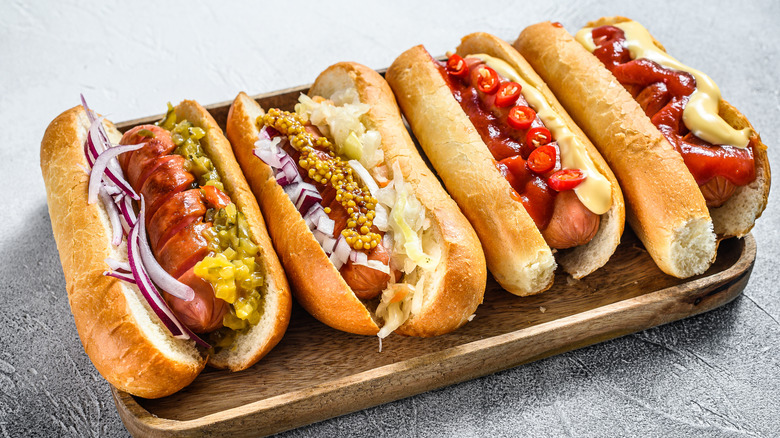Here's What Makes A Tijuana Hot Dog Unique
All your friends are over to celebrate the weekend, tailgate the football game, or have a cookout, and one of the easiest meals that will keep everyone satisfied is cooking on the barbecue. As they cook, the distinctive smell coming from the grill has your mouth watering while you get the buns and toppings ready. We're talking about hot dogs, of course! According to the National Hot Dog and Sausage Council, the ballpark and summer classic continues to be a favorite during the summer between Memorial Day and Labor Day, or peak hot dog season, with more than 7 billion hot dogs and 818 hot dogs per second consumed during that time of the year.
While you can't beat a simple hot dog with your choice of ketchup or mustard on a delicious bun, loading up the toppings or trying a different variation on the American staple is a fun way to experiment with the dish. New York, Chicago, and other U.S. cities all have their own take on the food that largely affect the toppings added. A new version of the dish based on Mexican street food is gaining popularity. The Tijuana hot dog is a great variation that is absolutely delicious, but what exactly is it?
A Tijuana hot dog is wrapped in bacon
The Tijuana hot dog is inspired by Mexican street food. Hot dogs are served in many different ways from food carts for anyone looking for a filling snack or meal, and in Tijuana a specific style has emerged and started catching on in American cities like San Francisco and Los Angeles. First We Feast breaks down the key details of the Tijuana hot dog in their list of regional hot dog styles, revealing what makes the dish so delicious.
The special ingredient that makes a Tijuana hot dog is bacon. The wiener is wrapped in delicious slabs of meat before it is put on the bun and served. In the most popular method, the hot dogs are cooked, wrapped in bacon, and deep-fried before being topped with fried onions and mayonnaise. Bacon and fried food are popular comforts across the U.S., so it's easy to see why the Mexican street food has caught on north of the border and started spreading to different Californian cities and beyond.

